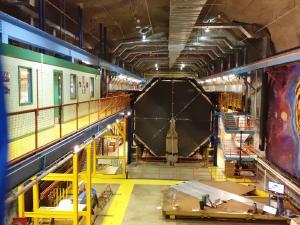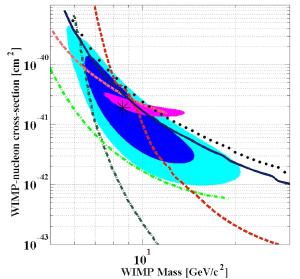Post
Mine Over Matter
17 April 2013
 Brian Koberlein
Brian KoberleinMinnesota’s Soudan Underground Mine State Park is a former iron mine. Because of the orientation of the hematite, the mine had to go deep, and by the time of its close as an active mine in 1962 they were mining more than 2000 feet below ground level. Given its depth, and the geology of the region, the lower levels of the mine are well shielded from cosmic rays, which makes it a perfect location for sensitive experiments such as the search for dark matter. This is why it’s the location for the Cryogenic Dark Matter Search (CDMS).
The CDMS detectors are supercooled semiconductor detectors. When particles interact with the semiconductor material (germanium and silicon), it causes the atoms in the material to oscillate. Just how the atoms oscillate depends on the way a particle interacts. Most normal particles interact with the electrons in the semiconductors, since normal particles interact electromagnetically. But dark matter doesn’t interact strongly with electromagnetism. If dark matter is caused by Weakly Interacting Massive Particles (WIMPs) then they should largely ignore the electrons and instead interact with the nuclei of the semiconductors. This means that WIMP interactions would produce a different type of interaction than regular matter.
Of course distinguishing between regular particles and WIMPs requires minimizing all the background interactions from cosmic rays, which can also interact with nuclei. One way to minimize cosmic rays is to place the detectors at the bottom of an iron mine.
 Agnese, R., et al.
Agnese, R., et al.This month the CDMS team announced tentative evidence for dark matter,1 which you can see in the image here. Tentative is the key word here. The results are interesting, but not conclusive. Since WIMPs are weakly interacting, you have to sift through a great deal of observations to find a possible detection. For this particular project, CDMS-II, the team found three candidate observations. This is bigger than expected from simply background noise, but not by much. Model simulations predicted that three “false positives” had about a 1 in 20 chance of happening randomly. So finding three candidate observations is hardly a discovery.
However the three observations they found were consistent among themselves. If they were caused by cosmic rays they wouldn’t be expected to cluster. When you look at the recoil energies of these candidates, the odds of it occurring randomly is about 1 in 500. This means this observation is a 3-sigma event, meaning it is three standard deviations above “noise level.” In particle physics the standard is 5-sigma, or having odds of only 1 in 1.7 million of being random. So there is still quite a way to go before this could be considered a detection of dark matter.
The consistency of the results also allows us to compare it to WIMP models. If these are actual interactions with dark matter WIMPs, then the results give a WIMP mass of about 8.5 times the mass of a proton. This is surprising because the simplest dark matter models predict WIMPs to have a greater mass. So either these events aren’t due to dark matter, or dark matter is more complex than the basic models would have us believe.
The only way to resolve this matter is to get more data. That’s actually underway with the next generation CDMS, known as SuperCDMS Sudan, which has been collecting data for about a year.
It looks like we’ll just have to keep mining for data.
Agnese, R., et al. “Silicon detector results from the first five-tower run of CDMS II.” Physical Review D 88.3 (2013): 031104. ↩︎